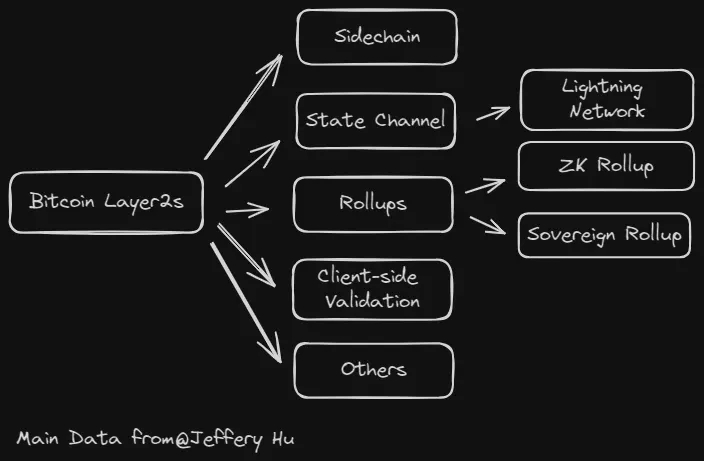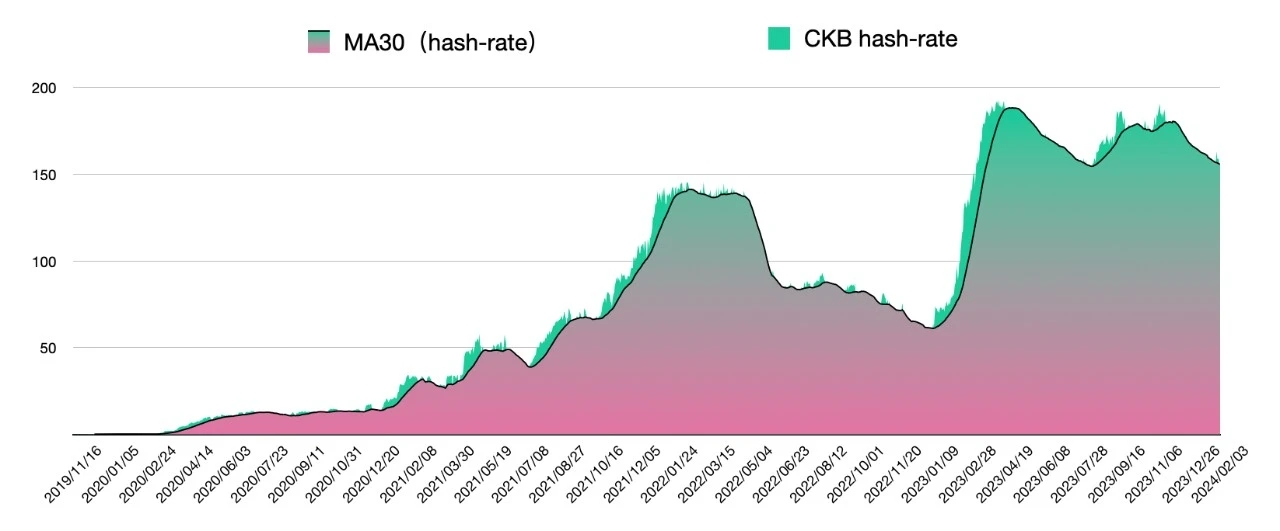After months of back-and-forth news, Trump was finally elected as President of the United States. Influenced by this positive news, Bitcoin surged📈, breaking through $75,000 to reach a historic high. The Bitcoin ecosystem also responded enthusiastically. Currently, in Bitcoin Layer 2, how to select the most promising coins has become the focus. Below, Da Meng will introduce the ace in Bitcoin Layer 2—CKB.
At the beginning of last year, the birth of the Ordinals protocol on the Bitcoin network broke the gloom of the bear market, like a fire in winter, igniting the Bitcoin ecosystem, which had been lukewarm and unnoticed. From Ordinals to BRC-20, and then to Atomicals, a series of innovative inscription protocols and asset standards continuously inject new vitality into the Bitcoin ecosystem.
The popularity of inscription assets like ORDI and SATS not only pushed Bitcoin inscriptions to unprecedented highs but also marked the arrival of a new era. Before this, the Ethereum ecosystem was dominant. After the surge in Bitcoin inscriptions, more and more users, developers, and funds began to pay attention to and participate in the Bitcoin ecosystem. One of the most obvious signals of this transformation is the emergence of numerous Bitcoin sidechains and Layer 2 projects. Currently, there are already over 34 projects publicly announced to develop Bitcoin Layer 2, many of which have completed significant funding rounds. If we include those that are still undisclosed, it's expected that over 100 will participate in the competition.
In this battle of hundreds of factions for Bitcoin Layer 2, it will inevitably start chaotically, but after the tide recedes, some projects will undoubtedly stand out. Among them, some may excel in marketing, while others may rely on solid technology, emerging as winners among the various technological architecture solutions in the Bitcoin Layer 2 arena. Among these winners, Nervos CKB will undoubtedly occupy a place. However, before analyzing CKB's advantages, it is necessary to clarify a question: what problems does Bitcoin Layer 2 really need to solve?
What problems does Bitcoin Layer 2 aim to solve?
Ethereum's Layer 2 has developed over the years, from the initial Sharding to later State Channels, Plasma, and finally Rollups becoming mainstream. The core of these Layer 2 solutions is to enhance the performance of Ethereum Layer 1, which involves packaging most Layer 1 transactions into the Layer 2 network to relieve pressure on the mainnet.
The transaction processing speed (TPS) of Bitcoin is about 7 transactions per second, which is relatively low. Therefore, any form of Layer 2 technology will undoubtedly greatly enhance its performance. The biggest problem with Bitcoin is that it is not Turing complete, and the lack of support for smart contracts limits the development of more complex ecological business around Bitcoin. With the emergence of protocols and standards like Ordinals, BRC-20, and Atomicals, the issuance of assets on the Bitcoin chain is no longer a challenge. The current pain point has shifted to how to create more application scenarios or more use cases for these assets.
Therefore, the primary task currently facing Bitcoin Layer 2 is to expand Bitcoin's very limited programming capabilities, which we often refer to as: issue assets on Layer 1, build applications on Layer 2. The Layer 2 network aims to solve programming capabilities.
The current Bitcoin Layer 2 arena can be roughly divided into several directions based on different technical architectures: state channels, client validation & one-time sealing, Rollup, and sidechains.

Among them, state channels are represented by the Lightning Network, which achieves low-cost, high-speed, and highly scalable transaction confirmations by conducting transactions off-chain (in channels), submitting them to the main chain only when the channel is closed. However, the development progress for state channels is relatively slow, and complex channels may lead to uncertainty. Client validation and one-time sealing are mainly represented by RGB, with off-chain data storage and on-chain commitments, but the downside is slow progress and the inability to interact with smart contracts. Rollup is represented by BitVM, Bison, etc., but due to Bitcoin's characteristics, currently, no project can perfectly replicate the validation method of Rollup on Ethereum.
Sidechains are independent blockchains that usually have their own consensus mechanism and a set of independent validating nodes, connected to the main chain via a bi-directional cross-chain bridge or 2WP. Compared to other technological architectures, the development of sidechain solutions progresses faster. Therefore, in this round of the Bitcoin Layer 2 competition, sidechain solutions will become the main battlefield, where competition is most intense, with the most projects and the easiest results to observe. In this regard, CKB is the most promising.
CKB, the most promising Bitcoin Layer 2.
CKB went live in November 2019, adopting the PoW consensus mechanism and UTXO model, which is completely isomorphic to Bitcoin. Additionally, CKB has the Axon framework, enabling 'one-click chain issuance.'
In the current Layer 2 battle for Bitcoin, especially in the sidechain arena, CKB is considered the most promising because it has unparalleled advantages over other sidechain solutions in terms of security, scalability of Bitcoin programming capabilities, technical accumulation, and ecosystem.
First is security. Sidechains are independent blockchains that do not inherit the security of the main chain, so many sidechain projects often become centralized due to a lack of nodes. From the beginning, CKB has adopted the same, time-tested PoW consensus mechanism as Bitcoin, maximizing security and decentralization.
CKB's mining algorithm is independently developed Eaglesong. After April 2020, CKB successfully transitioned to the era of ASIC mining, overcoming the most dangerous moment of the PoW chain. The mining machines currently used for CKB are produced by Bitmain, the world's largest ASIC mining machine manufacturer. Currently, CKB's total network computing power is approximately 158 PH/s, successfully undergoing the first mining reward halving in November last year.

In terms of enhancing Bitcoin's programming capabilities, CKB has generalized the UTXO model and named it the Cell model. Like UTXO, a Cell is also a transaction output, but it generalizes the amount in UTXO into capacity and data, transforming a space originally for storing integers into a space for storing arbitrary data. Additionally, the data structure of a Cell includes LockScript and TypeScript, with the former mainly reflecting ownership and the latter allowing for the customization of various rich functions, such as implementing functionalities that do not yet exist on Bitcoin, like Covenants. In the Cell scripts, developers can also specify cryptographic primitives based on their needs, providing great flexibility. In summary, the Cell model inherits the fundamental philosophy of Bitcoin's UTXO, making it easy for CKB to inherit Bitcoin's simplicity and security while cleverly modifying it to support smart contracts.
In addition to the highly flexible Cell model, CKB's virtual machine is also very powerful. It uses the open instruction set RISC-V, allowing developers to create smart contracts in any language as long as they compile it into RISC-V binary format with the appropriate compiler. This is not only efficient but also supports a variety of cryptographic algorithms, whether it's Bitcoin's original Secp256k1 or the later introduced Schnorr, which can be directly ported to run on the CKB blockchain.
In terms of user experience, CKB's mainnet is fully compatible with BTC addresses and wallets, allowing users from the Bitcoin ecosystem to seamlessly enter the CKB ecosystem. The inscription protocol Omiga on CKB has supported the Bitcoin wallet UniSat, enabling Bitcoin ecosystem users to directly deploy, mint, and transfer inscription assets on the CKB chain using UniSat wallet. In contrast, users of account model EVM sidechains must switch wallets when transitioning from the Bitcoin ecosystem to EVM sidechains, leading to a fragmented user experience.
The four years of technological accumulation and the gradual improvement of infrastructure are also reasons why CKB is worth attention. On one hand, CKB has the Axon framework for 'one-click chain issuance,' enabling various Bitcoin inscription communities, such as Ordi, Sats, and Rats, to easily launch their own BTC Layer 3 on CKB. On the other hand, CKB's development tools are also increasingly refined; in addition to various toolkits and SDKs contributed by the core development team, community teams are actively contributing, such as the PW SDK developed by the Lay2 team for building CKB dApps, and the Kuai project by the MagickBase team aimed at significantly lowering the barriers to dApp development.
In terms of ecosystem, CKB is far ahead of other sidechains. The JoyID wallet uses biometric technology (fingerprint/face scan) to create and manage wallets, allowing users to use it without any blockchain knowledge. It also supports multiple chains, making it more powerful in functionality than MetaMask, and its user experience is on par with Web2 applications. CKB has its own DID system (.bit), which also supports multiple chains and Passkeys, offering more powerful functionality and better compatibility than Ethereum's ENS, and has already secured $13 million in Series A funding. The inscription protocol Omiga and the NFT protocol Spore Protocol, which stores data fully on-chain, are both online. Other infrastructures like DEX and cross-chain protocols are in the testing phase and will be launched soon. The decentralized full-chain liquidity protocol Khalani, which provides infrastructure for DeFi, is also in the testing phase.
In summary, CKB, with its excellent security, innovative technical solutions, rich technical accumulation, and an increasingly完善的生态系统, will become the most anticipated Bitcoin Layer 2. CKB will not only provide new possibilities for expanding Bitcoin's programming capabilities but also offer developers and users a secure, flexible, and user-friendly blockchain environment. As technology continues to mature and the ecosystem develops, CKB will undoubtedly play an increasingly important role in exploring the forefront of Bitcoin Layer 2.






